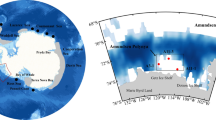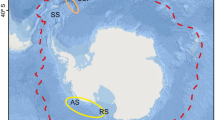Abstract
The effects of oceanic and biotopic factors on the size and age at maturity of sea urchins Strongylocentrotus intermedius alongside the northwestern coast of Primorsky krai are discussed. The growth rate and body size of the sea urchin at 50% maturity of the population corresponds to 30–35 mm in clusters with high growth rates and to 20–22 mm in clusters with low growth rates. In populations inhabiting southern areas of northern Primorsky krai, S. intermedius reaches final maturity at 40–45 mm, while in areas further to the north, at 26–30 and 31–35 mm. The age at final maturity in areas between Ezhovaya Bight and Cape Khitrovo and along Cape Nadezhdy was 4+ to 5+, while in other areas it was 3+. We argue that the differences in sizes and time periods in which maturity is reached in various S. intermedius populations depend on the local environment within the studied coastal area, primarily, on the abundance of available food, rather than on latitudinal zoning.





Similar content being viewed by others
REFERENCES
I. S. Arzamastsev and B. V. Preobrazhenskii, Atlas of Submerged Relief of the Sea of Japan (Nauka, Moscow, 1990) [in Russian].
A. G. Bazhin and D. M. Lourens, “Analysis of the types of life strategies of sea urchins as a method for assessment of their possible use in aquaculture,” Sb. Nauchn. Tr. Kamchat. Nauchno-Issled. Inst. Rybn. Khoz. Okeanogr., No. 17, 73–86 (2010).
A. G. Bazhin and V. G. Stepanov, Sea Urchins of Family Strongylocentrotidae from Russian Seas (Kamchatka Scientific Research Institute of Fisheries and Oceanography, Petropavlovsk-Kamchatskiy, 2012) [in Russian].
E. I. Blinova, O.Yu. Vilkova, D. M. Milyutin, and O. A. Pronina, Guide for Registration of Resources of Commercial Species of Hydrobionts in the Coastal Zone (VNIRO, Moscow, 2003) [in Russian].
E. E. Borisovets, Yu. E. Bregman, G. I. Viktorovskaya, and M. V. Kalinina, “Biology of the sea urchin Strongylocentrotus intermedius (A. Agassiz) at the northwestern coast of the Sea of Japan. Part 1: Distribution and size composition,” Izv. Tikhookean. Nauchno-Issled. Inst. Rybn. Khoz. Okeanogr. 127, 416–439 (2000).
Yu. E. Bregman, Candidate’s Dissertation in Biology (Far Eastern Scientific Center, Academy of Sciences of USSR, Vladivostok, 1973).
Yu. E. Bregman, “Population structure and growth of the sea urchin Strongylocentrotus intermedius (Agassiz) off the northwestern coast of the Sea of Japan,” Izv. Tikhookean. Nauchno-Issled. Inst. Rybn. Khoz. Okeanogr. 127, 397–415 (2000).
M. A. Vashchenko and P. M. Zhadan, “Impact of constant pollution of marine environment on reproductive function of invertebrates,” Tikhookean. Med. Zh., No. 2, 110–114 (2012).
G. I. Viktorovskaya and V. I. Matveev, “Relation between the time of reproduction of the sea urchins Strongylocentrotus intermedius and the water temperature of the northern Primor’e coast,” Oceanology (Engl. Transl.) 40, 73–78 (2000).
G. I. Viktorovskaya and L. G. Sedova, “Biology of the sea urchin in the central region of northern Primorye,” Izv. Tikhookean. Nauchno-Issled. Inst. Rybn. Khoz. Okeanogr. 127, 382–396 (2000).
G. I. Viktorovskaya, L. G. Sedova, E. E. Borisovets, V. I. Matveev, M. V. Kalinina, and Yu. E. Bregman, “Biological characteristic of agglomerations of sea urchin Strongylocentrotus intermedius (Agassiz) in the coastal zone of Primorye (Sea of Japan),” Izv. Tikhookean. Nauchno-Issled. Inst. Rybn. Khoz. Okeanogr. 139, 225–259 (2004).
A. G. Voronov, Geobotany: Manual for higher Education Institutions, 2nd ed. (Vysshaya Shkola, Moscow, 1973) [in Russian].
S. Glantz, Primer of Biostatistics (McGraw-Hill, New York, 1981; Praktika, Moscow, 1998).
S. M. Gnezdilova, Candidate’s Dissertation in Biology (Far Eastern Scientific Center, Academy of Sciences of USSR, Vladivostok, 1971).
A. Yu. Dubinina and A. O. Zolotov, “Fecundity and maturing of the northern rock sole Lepidopsetta polyxystra Orr et Matarese (2000) on the Pacific shelf of Kamchatka,” Izv. Tikhookean. Nauchno-Issled. Inst. Rybn. Khoz. Okeanogr. 172, 119–132 (2013).
M. V. Kalinina, G. I. Viktorovskaya, E. E. Borisovets, Yu. E. Bregman, and V. N. Kulepanov, “Biology of the sea urchin Strongylocentrotus intermedius (Agassiz) off the northwestern coast of the Sea of Japan. Part 2: Reproductive characteristic,” Izv. Tikhookean. Nauchno-Issled. Inst. Rybn. Khoz. Okeanogr. 131, 249–265 (2002).
M. V. Kalinina, I. S. Gusarova, G. S. Gavrilova, and G. I. Viktorovskaya, “The influence of environmental factors on the reproduction of sea urchins in various biotopes of the Peter the Great Bay,” Izv. Tikhookean. Nauchno-Issled. Inst. Rybn. Khoz. Okeanogr. 127, 490–511 (2000).
M. V. Kalinina, I. Yu. Sukhin, and G. I. Viktorovskaya, “Impact of biotopic conditions on the gonads of the sea urchin Strongylocentrotus intermedius (the Peter the Great Bay, Sea of Japan),” Vopr. Rybolov. 5, 147–164 (2004).
V. L. Kas’yanov, Reproductive Strategy of Marine Bivalve Mollusks and Echinoderms (Nauka, Leningrad, 1989) [in Russian].
A. I. Kafanov and V. A. Pavlyuchkov, “Ecology of commercial sea urchins of genus Strongylocentrotus of the Sea of Japan continental coast of Russia,” Izv. Tikhookean. Nauchno-Issled. Inst. Rybn. Khoz. Okeanogr. 128, 349–373 (2001).
A. S. Konstantinov, General Hydrobiology: Manual for Biological Specialties of Higher Education Institutions, 4th ed. (Vysshaya Shkola, Moscow, 1986) [in Russian].
V. N. Kulepanov and A. A. Eryshev, “The conditions of brown algae Saccharina japonica thickets in the coastal zone of Primorye,” in Proceedings of VII All-Russian Scientific-Practical Conference with International Participation “Natural Resources: Modern State, Protection, Commercial and Technical Use,” March 22–24, 2016 (Kamchatka State Technical Univ., Petropavlovsk-Kamchatskiy, 2016), Part 1, pp. 89–91.
G. F. Lakin, Biometry: Manual for Biological Specialties of Higher Education Institutions (Vysshaya Shkola, Moscow, 1990) [in Russian].
V. I. Lukin, “Bionomic types of the upper sublittoral of the Far Eastern seas of USSR,” in Proceedings of the Second All-Union Conference on Marine Biology “Biology of Shelf Zones of the World Ocean,” Abstracts of Papers (Far Eastern Scientific Center, Academy of Sciences of USSR, Vladivostok, 1982), Part 1, pp. 44–45.
N. V. Maksimovich, “Statistical comparison of growth curves,” Vestn. Leningr. Gos. Univ., No. 24, 18–25 (1989).
M. V. Mina and G. A. Klevezal’, Growth of Animals: Analysis at the Organism Level (Nauka, Moscow, 1976) [in Russian].
T. Kh. Naidenko, “The growth of the sea urchin Strongylocentrotus intermedius until maturity in laboratory culture,” in Study of Echinodermata Animals in Far Eastern Seas (Far Eastern Branch, Academy of Sciences of USSR, Vladivostok, 1987), pp. 83–97.
T. Kh. Naidenko and S. M. Dzyuba, “Growth and maturation of the sea urchin Strongylocentrotus intermedius in laboratory conditions,” Biol. Morya (Vladivostok), No. 4, 20–24 (1982).
V. P. Naidenko, A. S. Tret’yakov, and A. V. Shkoldin, “Dependence of the period of sexual maturation of the sea urchin Strongylocentrotus intermedius in Posiet Bay on habitat conditions,” in Submerged Hydrobiological Studies (Far Eastern Scientific Center, Academy of Sciences of USSR, Vladivostok, 1982), pp. 142–146.
B. V. Perobrazhenskii, V. V. Zharikov, and L. V. Dubeikovskii, Principles of Underwater Landscape Science (Dal’nauka, Vladivostok, 2000) [in Russian].
N. I. Selin, “Retrospective assessment of the production process in marine bivalve mollusks based on the analysis of local and latitudinal features of their growth,” in Proceedings of the X Congress of Hydrobiological Society of Russian Academy of Sciences, Vladivostok, September 28–October 2, 2009, Abstracts of Papers (Dal’nauka, Vladivostok, 2009), pp. 356–357.
I. Yu. Sukhin, “Comparative analysis of the content of the intestines of gray and black sea urchins,” Izv. Tikhookean. Nauchno-Issled. Inst. Rybn. Khoz. Okeanogr. 131, 306–314 (2002).
V. I. Kholodov, Transformation of Organic Matter by Sea Urchin (Regularia) (Naukova Dumka, Kiev, 1981) [in Russian].
Yu. S. Khotimchenko, I. I. Deridovich, and P. A. Motavkin, Reproduction Biology and Regulation of Gametogenesis and Spawning of Echinodermata (Nauka, Moscow, 1993) [in Russian].
S. S. Shvarts, O. A. Pyastolova, L. A. Dobrinskaya, and G. G. Runkova, Effect of Group in Populations of Aquatic Animals and Chemical Ecology (Nauka, Moscow, 1976) [in Russian].
M. O. Chalienko, “The group growth of the sea urchin (Strongylocentrotus intermedius) off the northwestern coast of the Sea of Japan,” Izv. Tikhookean. Nauchno-Issled. Inst. Rybn. Khoz. Okeanogr. 194, 3–17 (2018).
M. O. Chalienko, V. N. Kulepanov, and V. I. Matveev, “Effect of several environmental factors on the growth of sea urchin Strongylocentrotus intermedius off the northwestern coast of the Sea of Japan,” Izv. Tikhookean. Nauchno-Issled. Inst. Rybn. Khoz. Okeanogr. 195, 111–127 (2018).
Y. Agatsuma and H. Momma, “Release of cultured seeds of sea urchin, Strongylocentrotus intermedius (A. Agassiz), in the Pacific coastal waters of southern Hokkaido. I. Growth and reproductive cycle,” Sci. Rep. Hokkaido Fish. Exp. Stn. 31, 15–25 (1988).
Y. Agatsuma, “Ecology of Strongylocentrotus intermedius,” in Edible Sea Urchins: Biology and Ecology (Elsevier, Amsterdam, 2001), Vol. 32, pp. 333–346.
A. Fuji, “Studies on the biology of the sea urchin. II. Size at first maturity and sexuality of two sea urchins, Strongylocentrotus nudus and S. intermedius,” Bull. Fac. Fish. Hokkaido Univ. 11, 43–48 (1960).
M. Jensen, “Age determination of echinoids,” Sarsia 37, 41–44 (1969).
D. R. Johnson, T. P. Boyer, H. E. Garcia, et al., World Ocean Database 2013 User’s Manual: NODC Internal Report No. 22 (NOAA Printing Office, Silver Spring, MD, 2013).
K. Kawamura, “Ecological studies on the sea urchin Strongylocentrotus intermedius on the coast of Funadomari in the north region of Rebun Island (II),” Sci. Rep. Hokkaido Fish. Exp. Stn. 3, 19–38 (1965).
K. Kawamura, “Fishery biological studies on a sea urchin, Strongylocentrotus intermedius,” Sci. Rep. Hokkaido Fish. Exp. Stn. 16, 1–54 (1973).
M. C. Kenner and M. T. Lares, “Size at first reproduction of the sea urchin Strongylocentrotus purpuratus in a central California kelp forest,” Mar. Ecol.: Prog. Ser. 76, 303–306 (1991).
J. M. Lawrence, A Functional Biology of Echinoderms (Croom Helm, London, 1987).
F. Sellem and M. Guillou, “Reproductive biology of Paracentrotus lividus (Echinodermata: Echinoidea) in two contrasting habitats of Northern Tunisia (South-East Mediterranean),” J. Mar. Biol. Assoc. U.K. 87, 763–767 (2007).
W. P. Tertschnig, “Daily activity pattern and foraging dynamics of the sea urchin Tripneustes ventricosus in a tropical seagrass community and environment (Virgin Islands),” Mar. Ecol. 10 (1), 3–21 (1989).
R. J. Thompson, “Fecundity and reproduction effort in the blue mussel (Mytilus edulis), the sea urchin (Strongylocentrotus droebachiensis) and the snow crab (Chionoecetes opilio) from populations in Nova Scotia and Newfoundland,” J. Fish. Res. Board Can. 36, 955–964 (1979).
C. W. Walker, T. Unuma, N. A. McGinn, L. M. Harrington, and M. P. Lesser, “Reproduction in sea urchins,” in Edible Sea Urchins: Biology and Ecology (Elsevier, Amsterdam, 2001), Vol. 32, pp. 5–26.
Author information
Authors and Affiliations
Corresponding author
Ethics declarations
COMPLIANCE WITH ETHICAL STANDARDS
This article contains no studies involving animals as research objects.
CONFLICT OF INTEREST.
The authors declare that they have no conflict of interest.
Additional information
Translated by D. Martynova
Rights and permissions
About this article
Cite this article
Chalienko, M.O., Kalinina, M.V., Kulepanov, V.N. et al. Size and Age at Maturity of the Sea Urchin Strongylocentrotus intermedius along the Northwestern Coast of the Sea of Japan. Oceanology 61, 69–79 (2021). https://doi.org/10.1134/S0001437021010045
Received:
Revised:
Accepted:
Published:
Issue Date:
DOI: https://doi.org/10.1134/S0001437021010045




